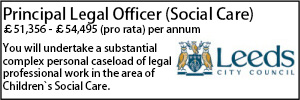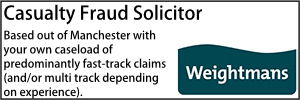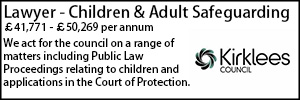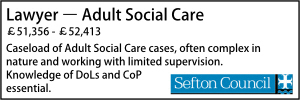Judges allow appeal by council over refusal of Family Court to make care order
The Court of Appeal has allowed an appeal by a local authority over the refusal of a Family Court judge to make a care order in respect of a girl, who is rising 2.
- Details
Lord Justice Baker concluded that the judge had failed to carry out the necessary evaluation of the evidence, and remitted the case for allocation to another judge.
The background to the case of H (Care Proceedings: Risk Assessment) [2025] EWCA Civ 727 was that H was the mother's fifth child.
In the course of proceedings between 2014 and 2015, her four older children had all been made subject to care and placement orders and subsequently adopted.
“The principal reason for their removal was the mother's repeated failure to protect the children from exposure to emotional harm arising from her relationships with abusive partners,” Lord Justice Baker noted.
In relation to H, HHJ Wicks in the Family Court had described the proceedings as a difficult and unusual case. “However, when I weigh the positives and negatives of each option for H against each other, I am not driven to the conclusion that nothing short of adoption will do in this case. In fact the conclusion I reach is that H can and should be returned to the mother's care.
“I am satisfied…. that the mother has continued to make changes, has continued to develop the necessary resilience and insight, and that this will enable her to protect both herself and H from the risks, both from the father and from any other individual with whom the mother forms a relationship in the future who turns out to be abusive.”
HHJ Wicks went on to dismiss the council’s application for a placement order and placed the girl, H, under the supervision of the local authority for 12 months.
The local authority appealed. Its principal argument was that the judge had failed to evaluate the current risks to H in the mother's care in the context of the mother's extensive history of violent relationships, her difficulties in keeping separated from abusive partners, her record of not working openly and honestly with professionals, and her failure to protect her children.
Lord Justice Baker said the central task for the Family Court in this case had been the evaluation of risk.
He said: “The context of that evaluation was the mother's very worrying history, extending over many years, of being trapped in abusive relationships in which her children were exposed to the risk of harm. The history also demonstrated repeated failures by the mother to work openly and honestly with professionals to alleviate the risk.”
The Court of Appeal judge said that pattern had continued when the mother was expecting H in 2023, and in the early stages of the present proceedings when, after completing an assessment in a residential unit and returning to the community, she secretly continued her relationship with the father, leading to a violent assault in her home in December 2023.
Lord Justice Baker said: “The judge was right to take into account the recent factors which were said to show an improvement in the mother's attitude to the father and her awareness of risk, but before he could safely conclude that she had developed ‘the necessary resilience and insight’ which would ‘enable her to protect herself and H from the risks from the father and from any other individual with whom [she] forms a relationship in the future who turns out to be abusive’, he needed to analyse the recent developments in the context of the mother's history.”
The judgment contained no such analysis, the Court of Appeal judge said. “Having recited in full the agreed findings on which the threshold criteria under s.31 were satisfied, the judge made no further reference to them in reaching his conclusion as to the extent of the future risks.”
Lord Justice Baker said it was “axiomatic” that a judge must consider the totality of the evidence.
“In this case, the judgment needed to include a summary and assessment of the evidence of the mother, the allocated social worker and the guardian about the issue of risk. I accept the local authority's submission that it was not enough for the judge to say that he did not propose to summarise the evidence he had read and heard in the case but that he had kept it all in mind when reaching his decision.”
Lord Justice Baker said the judge had made no reference to the evidence of the social worker or the mother, and his reference to the guardian's position included a misstatement of her recommendation.
“Given the importance attached to the recent developments which were asserted on behalf of the mother to demonstrate that the risks had reduced, it would have been preferable, in my view, for the judge to have heard further oral evidence from those three witnesses at the adjourned hearing in March 2025,” the Court of Appeal judge said.
“In the event, that course was not taken, and the only updating evidence was the social worker's written statement in which she expressed the view that the risks to H would remain until the mother accepted responsibility for her actions.”
Lord Justice Baker said it was incumbent on the judge to give some reasons for rejecting her evidence as to the continuing risk, but the judgment contained no reference to the statement at all.
The Court of Appeal judge said it was “equally axiomatic” that a judge must not treat the evidence in compartments but must consider each piece in the context of the rest of the evidence.
In this case, he added, the Family Court judge had “effectively left the threshold findings in one compartment, and then set out the agreed factors which indicated some improvement in the mother's capacity in a separate compartment, without analysing whether, and if so how and why, those factors alleviated the risk to H which was established by the threshold findings.
“Instead, he merely asserted, on the basis of those factors, that the risks had abated to such an extent that H could return to her care under a supervision order.”
Lord Justice Baker said that in this case, it was necessary for the Court of Appeal to intervene because the judgment did not provide any or any adequate explanation of the basis on which the judge concluded that the risks had abated to the extent that it was safe to allow H to return to the care of her mother.
“It is notable that he set out the matters which were not in dispute – the extensive factual findings of exposing her children to a serious risk of harm, stretching back over a number of years, on which the s.31 threshold was crossed and the recent factors which indicated a degree of improvement – but did not explain his reasons for concluding that the latter outweighed the former in the evaluation of risk,” the Court of Appeal judge said.
He suggested that this omission might have been avoided had the judge carried out an analysis of the relevant factors in the statutory welfare checklist.
“Those factors include, inter alia, under paragraph (e) "any harm … which the child has suffered or is at risk of suffering" and, under paragraph (f)(ii) "the ability … of any of the child's relatives … to provide the child with a secure environment". The welfare checklist thus provides the structure on which the necessary analysis of risk can be built. The judgment in this case was silent as to this analysis.”
Lord Justice Baker added that the deficiencies in the judgment in this case were not capable of repair through the process of seeking clarification.
He said the judge had recognised that his task in this case was as prescribed by Peter Jackson LJ in Re D (A Child: Placement Order) [2022] EWCA Civ 896 (paragraph 1), in a passage cited by the judge in his judgment,
"The court must therefore evaluate the family placement and assess the nature and likelihood of the harm that the child would be likely to suffer in it, the consequences of the harm arising, and the possibilities for reducing the risk of harm or for mitigating its effects."
Lord Justice Baker said that evaluation required a careful analysis of the evidence “which regrettably was not carried out in this case”.
The Court of Appeal judge allowed the local authority’s appeal and remitted the matter to the Family Presiding Judge for allocation to another judge.
“I stress that nothing I have said in this judgment should be read as indicating any view as to the eventual outcome. It may be that, after a full analysis of the evidence and the relevant factors in the welfare checklist, at the next hearing, the next judge will arrive at the same conclusion. But in any case where the threshold criteria under s.31 are satisfied, the decision as to the child's future care can only be made after such an analysis has been conducted,” Lord Justice Baker said.
Lord Justice Holgate and Mr Justice Cobb agreed.
































